Below is the most complete guide to crafting a property management chart of accounts you’ll ever need.
Never created a chart of accounts?
We’ll take you through it step-by-step.
Created one before, but never for property management/rentals?
We’ll offer specific tips and examples, including a sample chart of accounts for a real estate investors and property managers.
Looking for something specific? Use the table of contents to jump to the information you need quickly.
Or you can take these shortcuts:
- Download our free chart of accounts template. (We still recommend reading this guide to understand how to use it.)
- Schedule a free demo of DoorLoop to experience our full suite of property accounting tools, including a full chart of accounts, automatic rent collection, bank account reconciliation, robust reporting, and more.

With that said, let’s start from the beginning: what exactly is a chart of accounts and why is having one important?
What is a property management chart of accounts?

A chart of accounts is a list (i.e., chart) of all the different financial accounts related to your property business, whether you're a property management company or an investor/landlord.
This includes every type of financial account, including these and more:
- Tracking expenses
- Revenue
- Insurance
- Transactions of every kind
- Bills, such as utilities
- Credits
The best way to think of a chart of accounts is as a digital filing cabinet.
Imagine every financial action your business takes (or that affects your business) as a document, and each of those documents fits neatly into a particular folder.
Now you’ve got the idea.
Your chart of accounts isn’t just important for filing away financial information, though.
It’s the database you’ll pull from to craft important reports like your balance sheet, which helps you perform many tasks:
- Assess your business health
- Forecast its future performance
- Provide information to your banker and accountant
Your chart of accounts provides a foundation for a sound business structure, so it’s worth investing the time (or professional help) in crafting one that does the job you need it to do.
How does a chart of accounts work?
It can get complex, but when you break it down into steps, a chart of accounts for property management is pretty straightforward.
A chart of accounts organizes five major types of financial information:
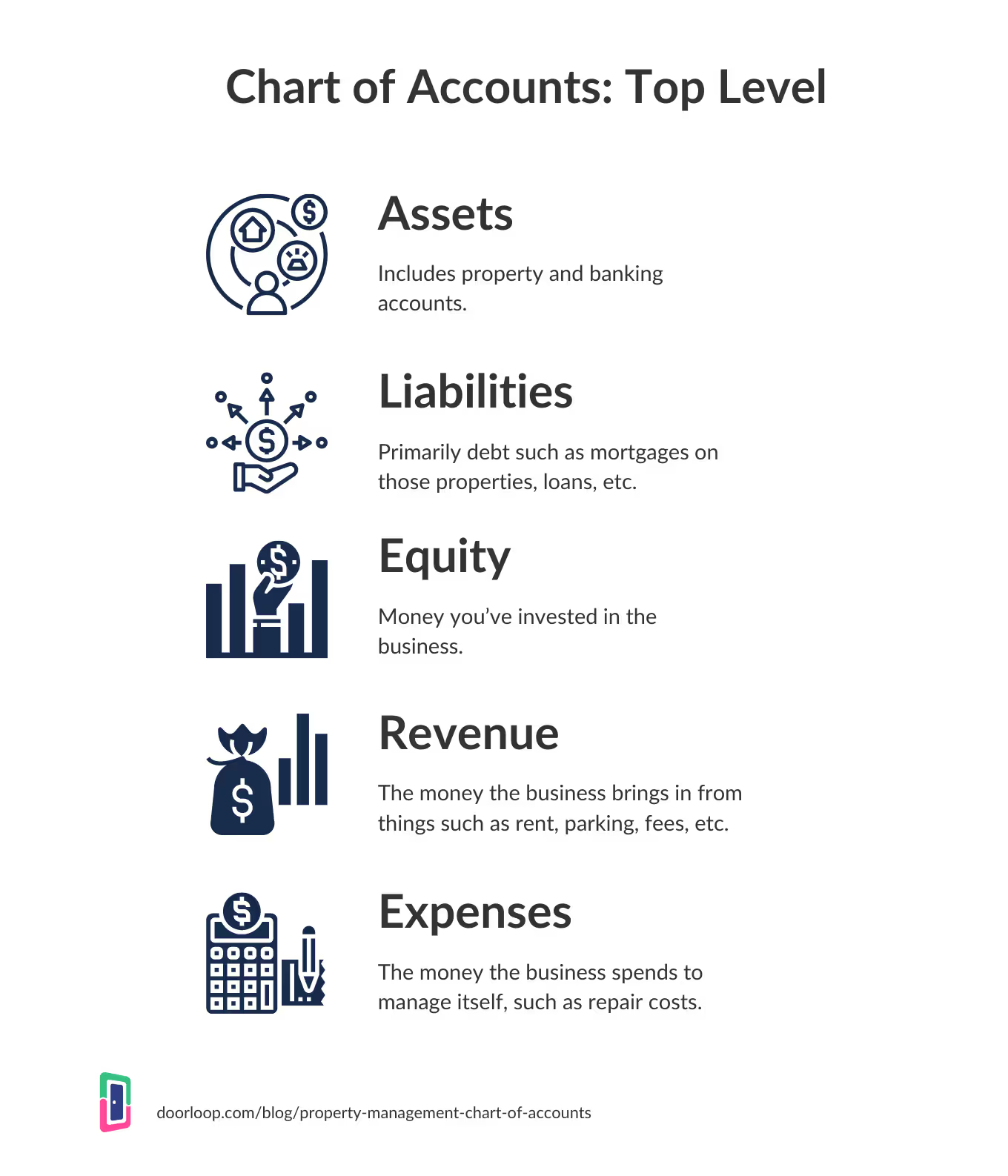
- Assets: This includes the properties, most notably, and financial accounts.
- Liabilities: This involves primarily debt, such as mortgages on those properties.
- Equity: This refers to money you’ve invested in the business.
- Revenues: This is the money the business brings in from things such as rent, parking, and other tenant fees.
- Expenses: This includes the money the business spends to manage itself, such as repair costs.
From there, you then break those primary accounts into sub-accounts. We’ll go over some specific examples in the next section.
Once you have that in place, every transaction that passes in or out of the business is recorded on that chart of accounts, be it a property sale, rent payments, or service cost.
That makes everything not only way more transparent for you and your clients but also easier for you to manage financial activity in virtually every way.
How to manually set up your property management chart of accounts in 3 steps
There is no standard structure for a chart of accounts, including one for managing property (be it rental property or other).
There are, however, suggested structures you can use as a kind of template.
A starting point, if you will.
(More like an easy button—check out the template later in this guide.)
If you’re managing a rental property, a good place to start for a suggested chart of accounts is IRS Schedule E (Form 1040).

Since you likely file that already, you’ll be familiar enough with it to understand how your current accounts break down into those major categories.
Our template below uses that form as a basis to make it as easy as possible to craft your chart of accounts.
The below isn’t just a rental property chart of accounts, though. You can use it for any kind of property management.
What about using a QuickBooks chart of accounts template?
Keep in mind that QuickBooks does have a generic chart of accounts template you can use.
However, because QuickBooks isn't designed specifically for property management, its templates typically need more modifications than the work you’d need to just make your own with a property management-specific focus (like the one below).
So, it’s not generally advisable to use one of QuickBooks’s templates.
Below, we’ll take you step-by-step through crafting a chart of accounts designed for managing a property.
Let’s start with step 1: establishing your number system.
1. Decide on your overarching number system
The first step in setting up a chart of accounts is deciding on your number system.
Typically, that’s done with something called “block numbering.”
That simply refers to the practice of “blocking” out or reserving large sequences of numbers for future use in accounting.
The basic idea is that, as a business grows, its number of accounts tends to grow in tandem.
Right now, you might have 20 asset-related accounts. But over time, that number will grow to 30, 40, etc.
If you select numbers 1-20 as your asset accounts, 21-40 as your liability accounts, 41-60 as your equity accounts, 61-80 for revenue, and 81-100 for expenses... what happens when you get your 21st asset?
It would have to become account number 101, which would just be downright confusing.
Instead, do it like this, using blocks of 1,000:
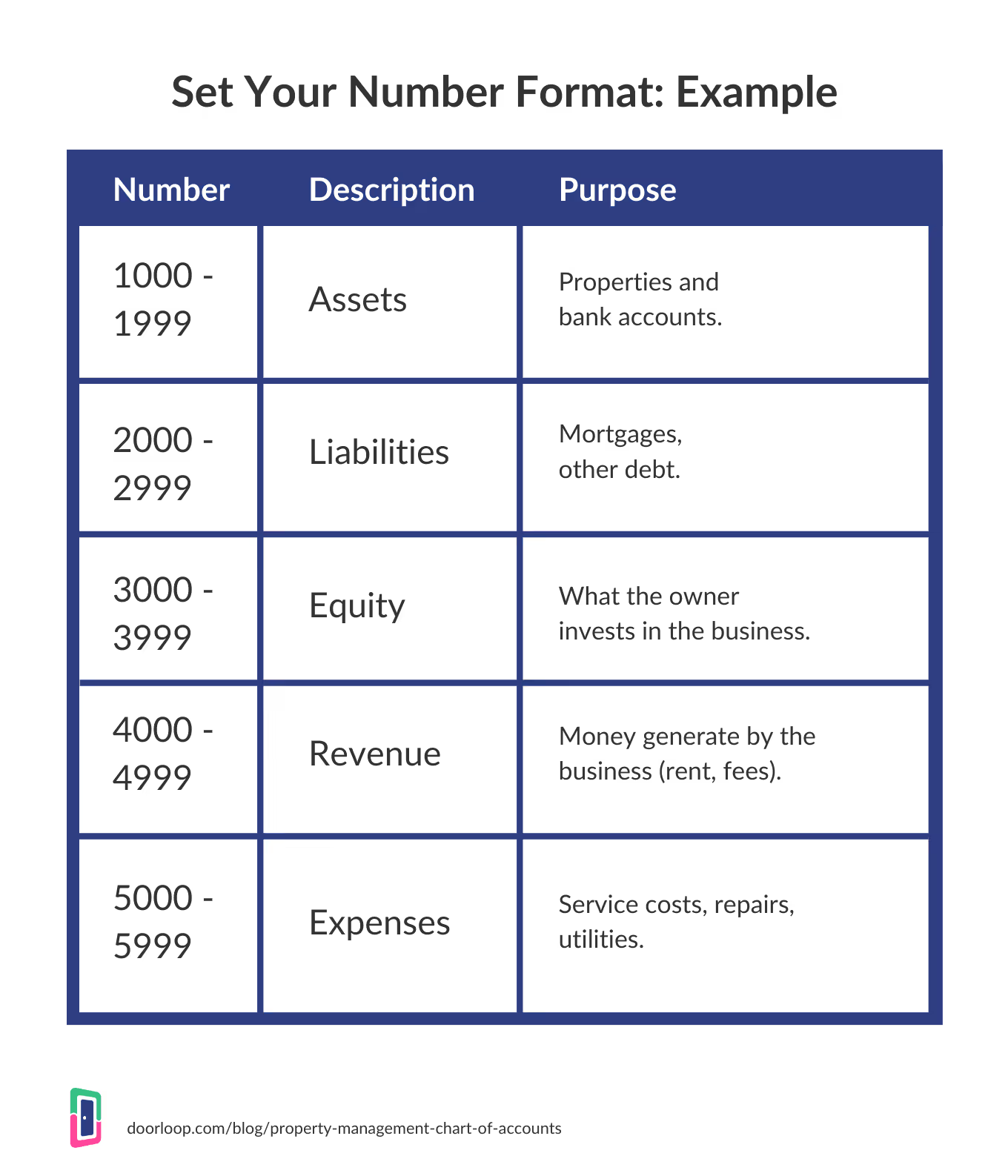
That way, you have more than enough space for new accounts.
Doing it this way not only keeps your chart of accounts from becoming a jumbled mess but also helps make identifying accounts easier.
With number blocking, you and your CPAs can easily identify what type of account it is by its first digit.
If it starts with a 2, you know it’s a liability. If it’s a 4, you know it’s a revenue account.
2. Set your level-2 accounts
Now that you have the basic architecture done, it’s time to drop in all of your level-2 accounts.
What kind of information fits into each of these five overarching categories?
Here’s a quick breakdown of what kinds of accounts are included in each:
a. Revenue accounts
If you manage or own rental property, this typically comes down to one main account: rent payments.
However, it also includes any other source of revenue:
- Utility payments (passthrough)
- Security deposits
- Parking fees
- Pet rent
b. Expense accounts
Your expense accounts are relatively easy to set up, as they’ll most likely be similar or identical to the 15 expense accounts listed on Form 1040.
That includes the following:
- Advertising
- Auto and travel
- Cleaning and maintenance
- Commissions
- Insurance
- Legal and other professional fees
- Management fees
- Mortgage interest paid to banks or other entities
- Other interest
- Repairs
- Supplies
- Taxes
- Utilities
- Depreciation expense or depletion
You can also include an “Other expenses” category for things that just don’t fit anywhere else.
However, that can get tricky come tax time, as the expenses will need to be identified somehow for both your accountant and the IRS.
c. Asset accounts
Most notably, you’ll include a line for each business bank account here.
Mortgage escrow accounts, land, buildings, and improvements are typically included here as well.
Accumulated depreciation is another common account, and it’s designed to track the depreciation of your assets over time. Specifically, the original value of those assets, the accumulated depreciation, and the net asset value via the balance sheet.
d. Equity accounts
Equity accounts essentially include two things:
- (Your) contributions
- Distributions
Or, in other words, what you put into the business and what you take out.
Expenses paid with cash are also included here, as they count as an owner contribution.
e. Liability accounts
Liability accounts include several types of accounts:
- Mortgages
- Loans
- Lines of credit
- Credit cards
- Security deposits
3. Property management chart of accounts example
Now that we’ve gone through the basics, it’s time to put it all together to see what our chart of accounts looks like.
Below, we’ve taken our five major categories (the 1,000s for assets, and so on) and added many sub-accounts based on what we talked about in step 1.
The result is a fairly fleshed-out chart of accounts example template for property management.

Whew!
Complex, but easy to read and chart where each account fits.
Keep in mind that you could use this as the basis for any kind of real estate business, including as a rental property chart of accounts template.
That said, let’s finish with the question you’ve likely already been asking yourself: how do you track multiple properties in your chart of accounts?
Let DoorLoop help you streamline your property accounting
Getting an accounting system set up that works for you can take a while, so it's understandable that once you find something that works, you don't want to switch.
The problem with this is that if you're tracking your accounting on a notepad or even spreadsheets, it takes way too much manual input.
You're trading time—easily hours each week—that you could otherwise use to do something else more productive or simply have more time to spend with family.
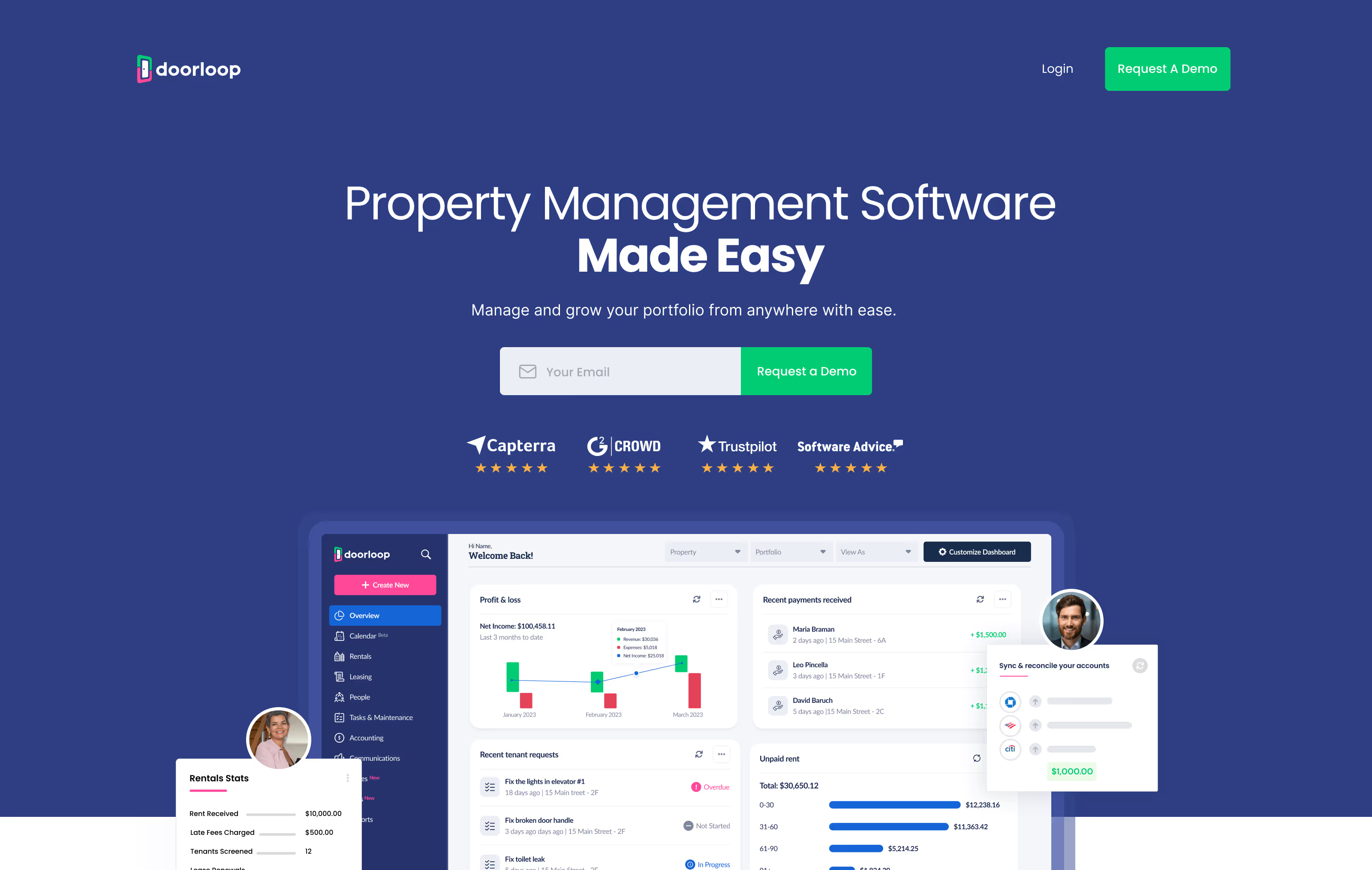
DoorLoop gives you that and more:
- Automatic rent collection
- Leasing tools
- A full maintenance management system that gives you the ability to set up workflows, make preventative maintenance easier, and reduce unexpected (and costly) repairs
The best part is that you can see what DoorLoop can do for you without paying a dime.
Schedule a free demo today to see how DoorLoop allows you to streamline your property accounting and much, much more.
How do you track multiple properties?
Taking the template example above, your Dwelling account is 1400.
So, to track multiple properties in your chart of accounts, you’d organize things like this, with another layer of sub-accounts:
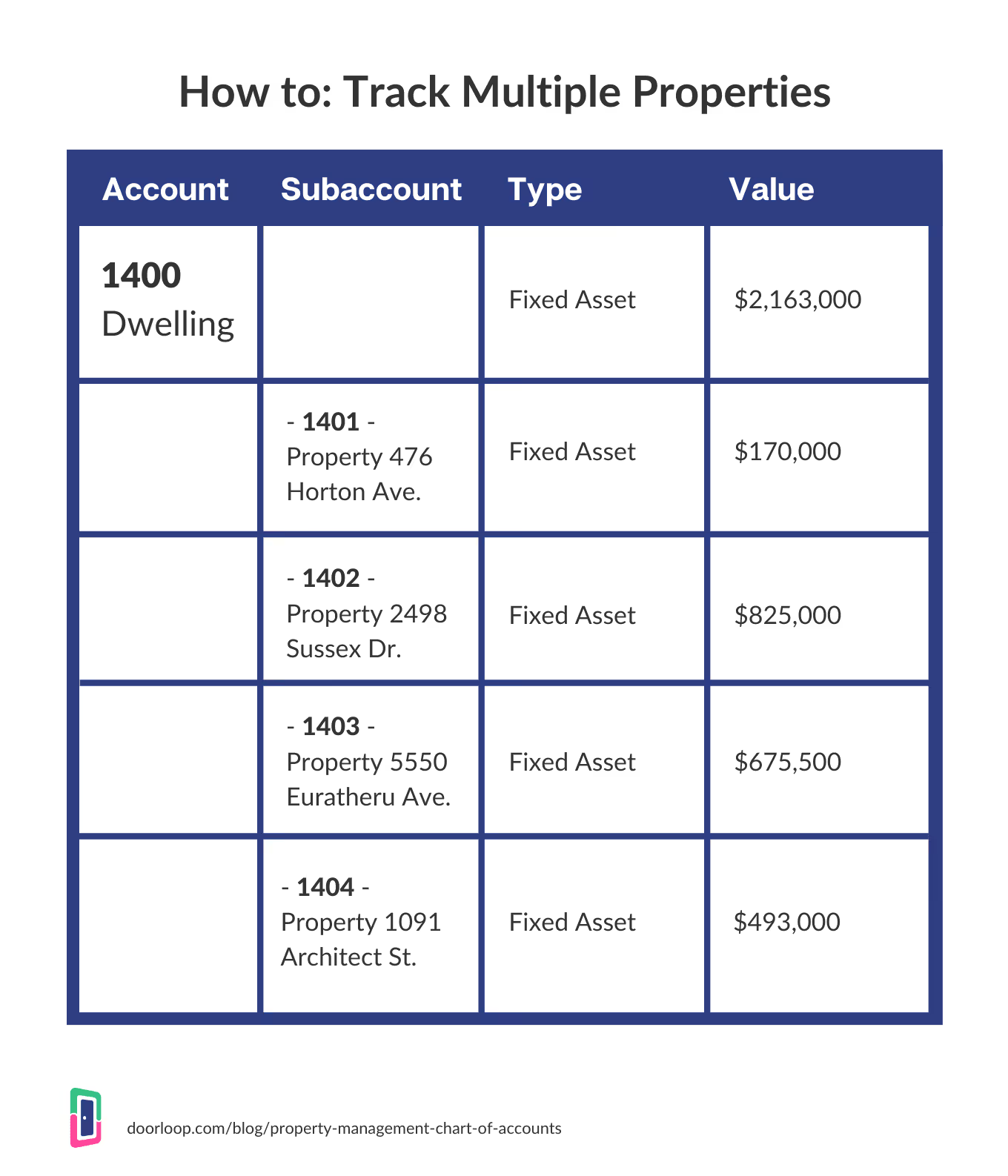
So, we know that anything starting with “1” (anything in the 1,000s) is an asset.
We also know anything in the 1400s (or starting with “14”) is a property (“Dwelling").
Now, we’ve also identified individual properties with their own third-degree identifier.
So the properties in the example are given the numbers:
- 1401
- 1402
- 1403
- 1404
With that, you have the 101 on crafting a property management chart of accounts.
A note on owner vs. property manager vs. landlord
One last quick note: how you craft your chart of accounts will vary somewhat depending on if you’re any of the following:
- The owner/investor themselves
- The landlord
- The property manager
For example, if you’re the property manager, then the rent payments you receive should be listed under “Liabilities,” just the same way as you’d list security deposits in liabilities.
You’d also want a separate revenue account for payments to you for your service.
Keep those subtle perspective details in mind when crafting your chart of accounts.
Free chart of accounts template download
Download our free property management chart of accounts template (in Excel format) so you can apply everything you learned from this guide or see if you forgot anything in your current setup.
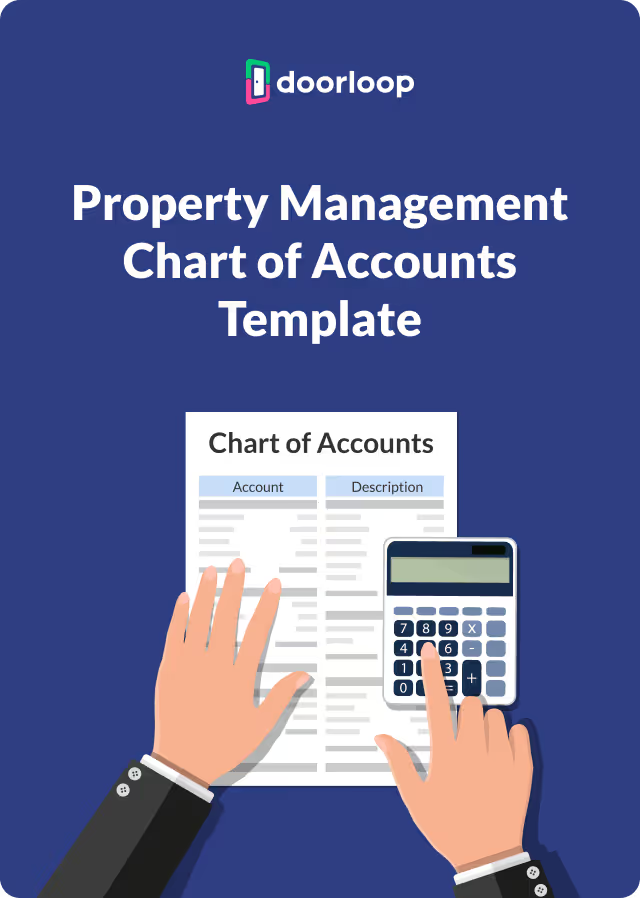
Manage your properties and your accounts with clarity
Creating a chart of accounts, whether you’re managing a few dozen properties or a few hundred, is key to organizing your accounts effectively.
With a good chart of accounts in place, you can run important reports you depend on with accuracy and empower you or your client’s property management with the most important kind of data: financial data.
It takes a bit of time to set up, but once you have the system up and running, you can easily pass it off to a CPA to manage, whether now or down the road.
Use the tips, steps, and examples we talked about in this guide to make the process of setting up your own chart of accounts simple and easy.
To learn more about property management, check out our plethora of resources, made to help you grow and scale up your property.
... and to see what DoorLoop can do for your business, schedule a free demo today!
Frequently Asked Questions
Do I really need a chart of accounts as a landlord?
Yes, having a chart of accounts is essential for landlords, even if you only manage a few units. It helps you organize income, expenses, assets, and liabilities in a clear, structured way, making tax time easier and giving you better visibility into your property's financial performance. Tools like DoorLoop include built-in charts of accounts tailored for property management, so you can stay organized from day one.
What categories should I include in a rental property chart of accounts?
A rental property chart of accounts should include categories for income (like rent, late fees, and application fees), expenses (such as maintenance, utilities, insurance, and property management fees), assets (like security deposits held), and liabilities (such as mortgage or tax obligations). You may also want to include equity accounts for owner contributions or distributions. Property management platforms like DoorLoop often come preloaded with these categories to help you get started quickly and accurately.
How do I track maintenance and repairs in my chart of accounts?
To track maintenance and repairs in your chart of accounts, create specific expense categories such as "Routine Maintenance," "Emergency Repairs," and "Capital Improvements." This lets you see where your money is going and helps distinguish between deductible expenses and long-term investments.
Can I use the same chart of accounts for multiple properties?
Yes, you can use the same chart of accounts for multiple properties, especially if you want consistent financial reporting across your portfolio. Most landlords set up property-specific tracking within each account using classes, tags, or sub-accounts.
How detailed should my chart of accounts be?
Your chart of accounts should be detailed enough to give you clear insights into your rental income, expenses, assets, and liabilities, but not so complex that it becomes overwhelming to manage. Aim for a balance: group similar expenses (like plumbing and electrical) under broader categories (e.g. “Repairs & Maintenance”), but keep key items distinct for tax and budgeting purposes. Tools like DoorLoop offer customizable templates to help you strike the right level of detail based on your portfolio size and goals.






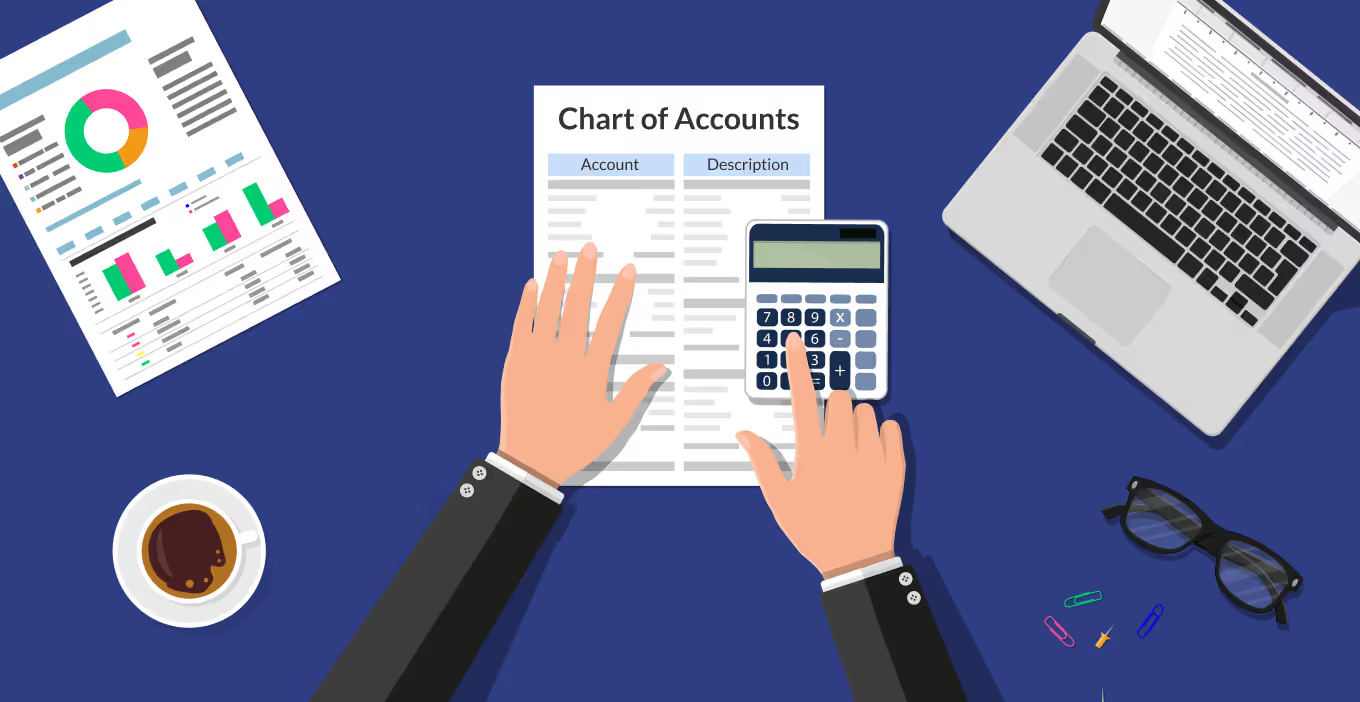






















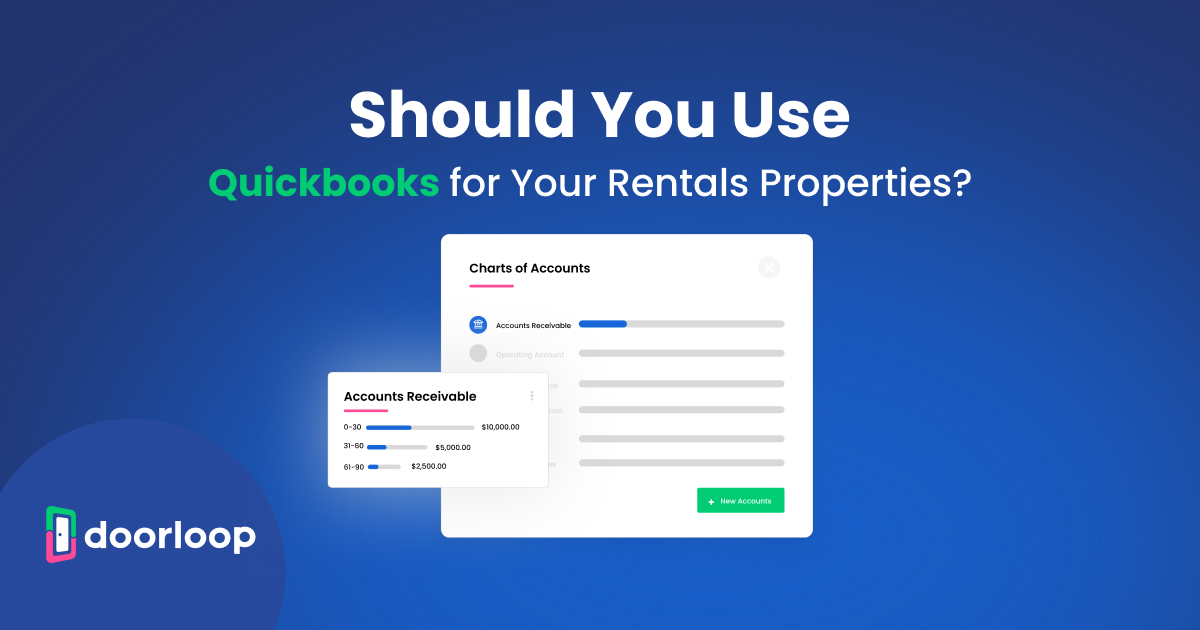

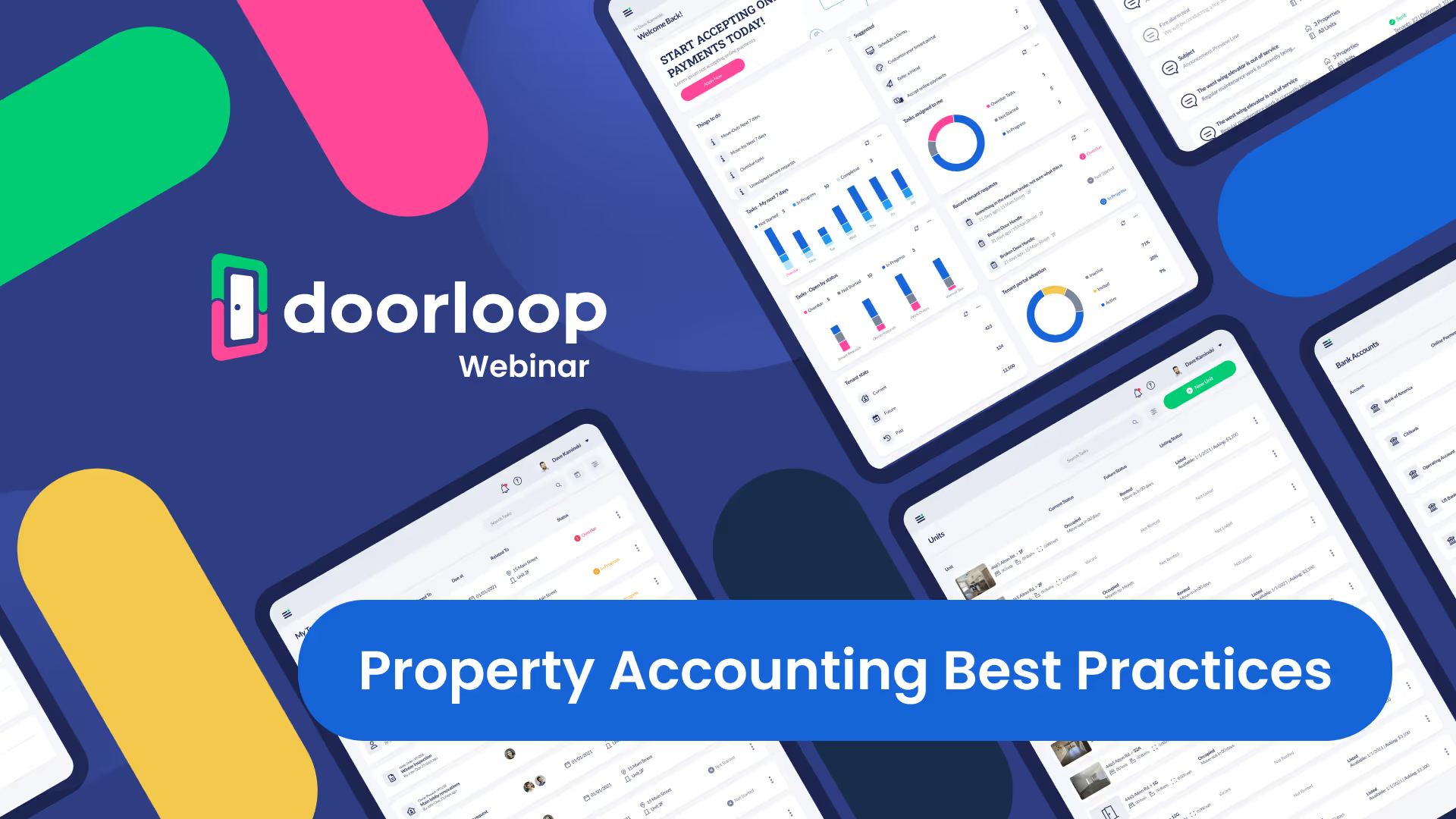
.svg)
.svg)

